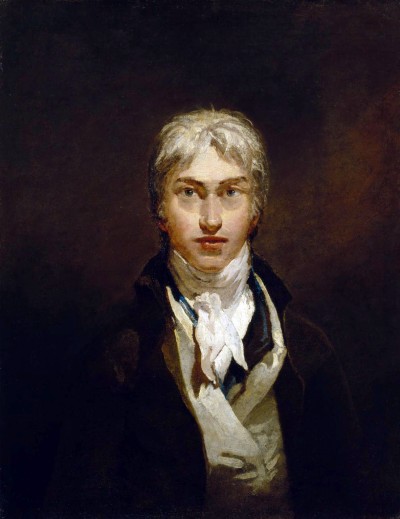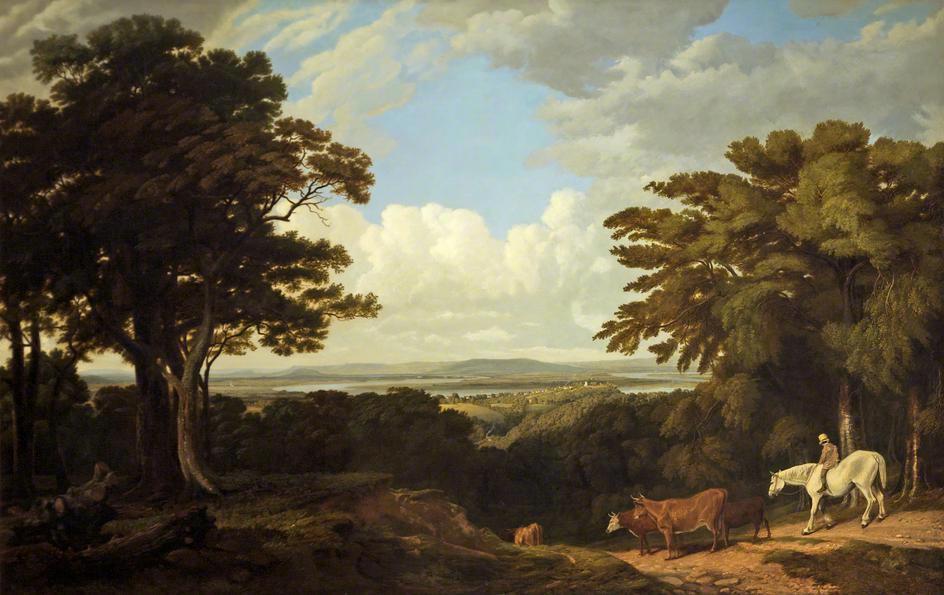Revisiting the Oracle: Artist J. M. W. Turner (1775-1851) at the Frick Collection in New York City

J. M. W. Turner is one of those rare artists who seem always to be ahead of us – as with Shakespeare, he remains somehow ever beyond our reach.
Turner’s Modern and Ancient Ports: Passages through Time is a thrilling exhibition currently on display at The Frick Collection in New York City, bringing together six oil paintings and some two-dozen watercolors from the artist’s middle period. This was a turning point in Turner’s career, the beginning of a shift towards ‘colour for colour’s sake’ – a romantic shift towards light and color as pure elements of inner experience, which bursts forth in the revolutionary works of the late period.
Joseph Mallord William Turner (1775-1851) was born in London, the son of a barber and wigmaker. The boy was a prodigy: by the age of fourteen he had entered the Royal Academy of Art; and at twenty-four, the youngest possible age, he was elected an Associate. He became a full member of the Academy in 1802. Intensely competitive, driven to be a painter as great or even greater then Rembrandt, Turner enjoyed tremendous success and popularity from an early age. As his later work became more daring and original he was criticized, sometimes excoriated, by contemporaries – but always acknowledged as a painter of genius.
Harbor of Dieppe: Changement de Domicile (c. 1825) and Cologne, the Arrival of the Packet Boat: Evening (1826) are contemporary port scenes in which Turner’s poetic representation of light and atmosphere has an almost intoxicating beauty. In Dieppe, Turner is already employing non-naturalistic color, golden hues which were more likely to be found in the southern Mediterranean, than in northern France. Marvelous details abound for the unhurried viewer: a family of ducks as they make their way past the boats; a young girl splashing her feet in the water, while on the lower right a young couple unload baskets and all the accouterments of daily life – the event, perhaps, being referenced in the subtitle (“Change of Address”). The incandescent illumination of sky, air and water, is striving for a phenomenology of light that transcends the mere representation of visual experience – one that traces the coming-to-appearance of time and memory, change and renewal.
Like its companion piece, Cologne is a grand-scale painting; a mesmerizing work which has the capacity to transfix and capture the viewer as under a spell. Nearing the shore is a packet boat with a band of spirited tourists aboard; meanwhile, peasant women carry lumber along the beach, a solitary dog laps water from the bank, and a neglected fishing apparatus floats idly in the shallows – Turner invests these ordinary sights with a sense of mystery. He embraces painting’s potential to make the everyday unfamiliar, to cast doubt – not unlike Rembrandt, who he would say, had the ability to “throw a mystery over the meanest piece of common.”
Cologne, the Arrival of a Packet-Boat: Evening, exhibited 1826 Oil on canvas 66 3/8 x 88 1/4 inches. The Frick Collection, New York Photo: Michael Bodycomb\
Turner’s colors have the power to produce in themselves various states of consciousness. He invents hues that suspend ordinary perception – both in the sense of prolonging and interrupting. His revolutionary use of color would seem to suggest, among other things, that color is able to summon forth untapped reaches of the mind – to invoke those ‘abysses of the past which are still in one just as much as the present.’
For the philosopher Gille Deleuze, Turner was the modern Pythia (otherwise known as the Oracle of Delphi). Like the puzzling pronouncements of the ancient priestess, Turner’s work makes a claim on us. He wants us to take our time – and he accomplishes this in part by leaving things ambiguous, never giving us all the answers. We see this, for example, in his paintings of ancient ports. In Ovid Banished from Rome (1838), the sun sets upon the ancient city with its temples, triumphal arches and statuary already dissolving into the mists of time, while in the foreground a man is being arrested – is this Ovid? – maybe the poet is already deceased (a tomb on the lower left bears his name). The overall feeling of the painting is one of irretrievable loss.
Regulus (1828) takes its name from the Roman general whom the Carthaginians condemned to stare at the sun until he went blind, before being executed. In Turner’s painting, the title character is all but impossible to find; and in searching for him the viewer is forced to share his fate, so to speak – to face directly the blinding luminescence of the sun. Here, as in so many of his land and seascapes, Turner insists that we bear witness; that we take up our position inside the work. Turner’s ports are truly portals – gateways luminous and large enough for us to enter with our whole being. The revolution in landscape painting that Turner achieved involved transcending the basic principle that “a landscape is something which unfolds before you.” His pictures envelop you and function in such a way as to “preclude the outside spectator.”
Turner was regarded as the greatest contemporary artist in the medium of watercolor; and experimented with various methods (including scratching out the paper) to achieve novel visual effects. Mont-St. Michel, Normandy (1827) is a small gem of a work, and no less mysterious and bewitching for its size. In a night scene, lit by the moon and torches, French officers are arresting smugglers on the flat sands exposed by low tide. A looming medieval abbey towers like a lonely mountain, beneath the gathering of dark and heavy clouds to create a sense of solitude and impending violence.
In writing about his late painting, The Angel Standing in the Sun (1846), Turner spoke of light devouring the entire visible world. For the great art critic John Berger (who passed away earlier this year), the devouring light is “close to the new productive energy” which was doing away with all previous notions about wealth, labor, distance, time and so much else. Turner’s attunement to the rapid changes wrought by industrialization is evidenced by the sensitivity with which he depicts smokestacks, steamboats, and laborers toiling through the night beside the red-hot glow of furnaces. In the entrancing watercolor Shields, on the River Tyne (1823), workers shovel coal from small boats onto a cargo ship, beneath the pale glow of a full moon.

Turner’s obsession with light is also indeed an obsession with the migration of light. Light travels: it journeys the sea and creates a kind of luminescent road over the surface of the ocean that stretches to the horizon and seemingly beyond. The light is infinite, and Turner is surely a painter of the infinite if ever there was one. Ultimately, Turner’s devotion to light is not some form of proto-impressionism: his quest is more a theological than a phenomenological one. Light is literally the royal road to God, the absolute, the divine.
The thread that seems to run through so many of these works, disturbing their general sense of tranquility, is not simply that the world of yesterday is fading – transformed by the emerging Industrial Revolution – and literally melting away into the tinted haze. Turner’s ports and coastal scenes having a way of insisting on our inherent vulnerability and the precariousness of human endeavor in the face of nature’s elemental forces. It is almost as if we are seeing the world sub specie aeternitatis – from the standpoint of eternity, from the standpoint of the all-consuming light itself.
Turner was far more than a virtuoso painter of windswept seas, of ocean vessels, and radiant cascades of yellow, blue and orange; one walks away from these pictures with the sense of taking ones leave from a long farewell. The world is a theophany, an appearance of God, for Turner – an almost Spinozistic God in which all things are ultimately dissolved in and through the infinite substance of Light. It is not simply the ever-changing effects of light that ultimately obsesses Turner, but the impermanence and evanescence of all things under the sun.
Sam Ben-Meir, PhD is an adjunct professor at Mercy College. His current research focuses on environmental ethics and animal studies.
[email protected] Web: www.alonben-meir.com
For media inquiries, contact Kim Hurley at 212.600.4267 or at [email protected].


